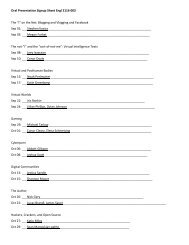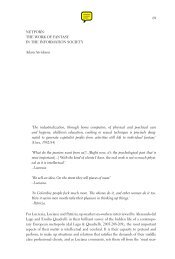Nakamura, Digitizing Race, Introduction, chapter 5, Epilogue
Nakamura, Digitizing Race, Introduction, chapter 5, Epilogue
Nakamura, Digitizing Race, Introduction, chapter 5, Epilogue
You also want an ePaper? Increase the reach of your titles
YUMPU automatically turns print PDFs into web optimized ePapers that Google loves.
178 Measuring <strong>Race</strong> on the Internet<br />
and have an impact as well on what users can create, nonetheless opportunities<br />
exist for the production of surprising modes of media creation within<br />
these constraints. Relative latecomers to the Internet, such as people of<br />
color, women, youths, and working- to middle-class users, have never owned<br />
the means to produce cultural texts on the Internet in the same way that<br />
more technically skilled and better-capitalized users have. Indeed, “complex<br />
and contradictory ‘living room wars’ are taking place wherever and whenever<br />
television (and other media) sway people’s daily lives in the modern<br />
world.” 17 However, “dailiness” varies across subject positions of various<br />
users, and assessing it must involve considerations of place and context of<br />
use as well as the racial and gender identity of users. The wars over the<br />
Internet’s visual culture are taking place in settings that include the living<br />
room, but also extend outward in ways that other media have not. The<br />
Internet intervenes in people’s daily lives across social spheres and public<br />
spaces such as public libraries, cybercafés, and school classrooms and across<br />
platforms like the cell phone, the PDA, and the television. Though, as<br />
Anna McCarthy notes, television itself has become an “ambient” medium,<br />
newly common in waiting rooms, vehicles, and public spaces, television’s<br />
migration out of domestic space and into public space has been driven<br />
partly by the influence of digital media. The Internet is a paradox: notable<br />
for the ways in which scholars have predicted its “ubiquity,” it is nonetheless<br />
far from universally accessible inside or outside the context of the living<br />
room. 18<br />
I focus here on the ways that influential and widely cited demographic<br />
studies of Internet users broken out by race, such as those released by the<br />
Pew Internet and American Life Project and the NTIA, represent Internet<br />
users as more or less passive mass audiences and “selective individualized<br />
consumers.” This characterization of Internet use creates a discourse of race<br />
and the visual culture of the Internet that envisions minorities as more or<br />
less successful consumers of a commodity or information source rather than<br />
as producers or active audiences. Even in cases in which Internet users of<br />
color do engage with the Internet mainly as consumers, participation in<br />
online petitions used to protest retail racism, as in the case of the Abercrombie<br />
and Fitch T-shirts, and media racism, as in the case of a controversial<br />
“Asian or Gay?” article in Details magazine, demonstrates not only that<br />
users of color use the Internet to organize and protest, but more importantly<br />
how they use the form of the petition itself to enable discourse that reveals<br />
ambivalent, complex and rich understandings of racial identity. Already-





